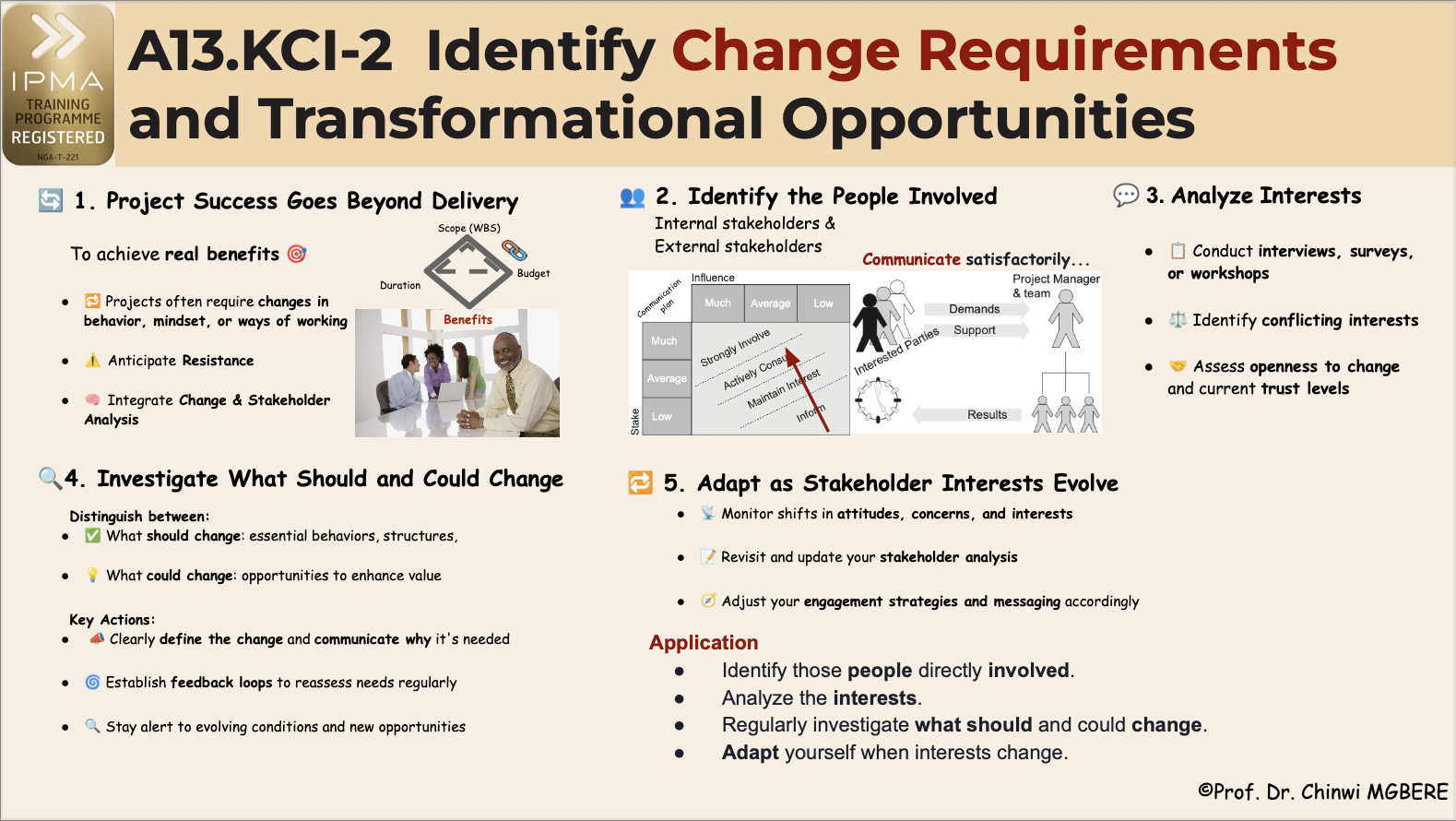

LESSON 2: IDENTIFY CHANGE REQUIREMENTS AND TRANSFORMATIONAL OPPORTUNITIES
CPD: 2 hours

Identify People Involved Begin by identifying all individuals and groups directly or indirectly involved in or affected by the project, programme, or portfolio. This includes internal stakeholders (such as team members, management, and other departments) and external stakeholders (such as clients, suppliers, regulators, or community groups). • Create a stakeholder map or register. • Categorize stakeholders based on their roles, influence, and impact. • Ensure all relevant parties are captured early and reviewed regularly.
Analyze Interests Once stakeholders are identified, analyze their individual and collective interests, expectations, and concerns. Understanding what motivates them, what concerns they have, and how they define success will provide insights into potential areas of resistance or support. • Conduct interviews, surveys, or workshops to gather insights. [This helps clarify where there may be alignment or conflict with project goals.] • Identify any conflicting interests or dependencies. [This helps recognize potential resistance based on perceived threats to personal or organizational interests • Assess the level of engagement and openness to change. [Build trust through empathy and open communication]
Investigate What Should and Could Change Determine what needs to change to enable the successful realization of benefits. These changes may be related to behaviors, processes, structures, technologies, or mindsets. • Define clearly what the change entails and why it is necessary. [Identify what changes are necessary in the current context to support the adoption and sustainability of the delivered solutions] • Communicate change needs in a transparent and compelling way. • Consider both what should change (necessary) and what could change (opportunistic) based on new information or evolving conditions. [Examine what additional changes could enhance value, mitigate risks, or seize new opportunities] • Establish feedback loops to reassess change needs at different stages. [Engage stakeholders in ongoing dialogue to explore and validate these changes.] Remember, change requirements may evolve as the project progresses, so maintain a flexible and proactive mindset.
Adapt When Interests Change Stakeholders’ interests and priorities can shift over time due to internal or external factors such as organizational changes, market dynamics, or new leadership. Remaining flexible and responsive to these changes is critical for maintaining alignment and momentum. • Monitor changes in stakeholder attitudes, concerns and interests throughout the lifecycle of the initiative. • Revisit the stakeholder analysis regularly and update communication and engagement strategies accordingly. [Maintain open channels of communication to detect subtle shifts early] • Reassess and re-prioritize change actions when interests evolve • Adjust your engagement strategies, messages, and actions accordingly. [Be prepared to adjust the change approach, reframe messages, or provide additional support to maintain buy-in]. Could you please revise this narrative for clarity of understanding, restructure and suggest icons to enhance learner engagement and retention?
Application
You can convert the above into actions on the project/programme/portfolio for which you are currently responsible, by carrying out the following steps:
Identify those people directly involved.
Analyze the interests.
Regularly investigate what should and could change.
Adapt yourself when interests change.